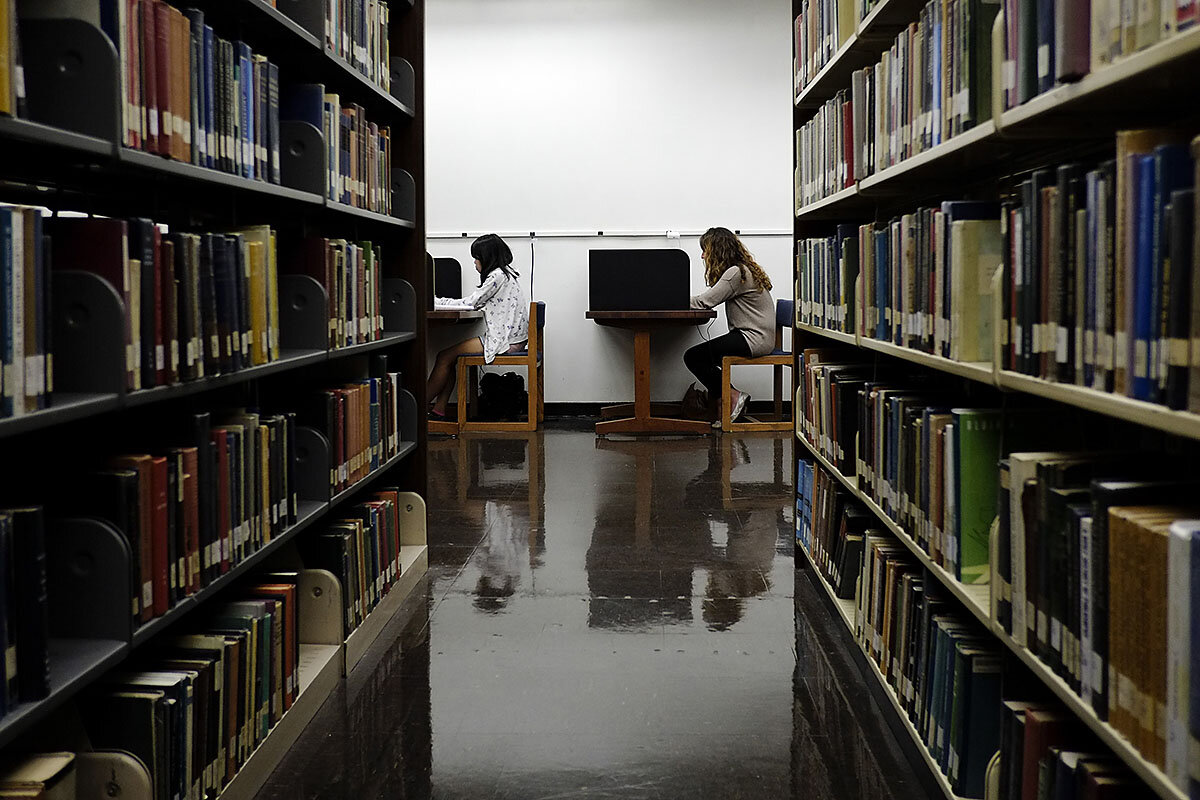Colleges ponder: Are remedial classes the best way to help?
Loading...
| Los Angeles
Lulu Matute still remembers the sinking sensation she felt when she heard the news.
It was the fall of 2012, and Ms. Matute had just taken the placement exam that gauged every prospective college student’s skill in math and English. She had hoped to earn her associate’s degree at the City College of San Francisco (CCSF) and transfer to a four-year institution within two years. “But based on the layout my counselor gave me, I was going to be there for three and a half, because I was starting at the lowest-level math,” she says.
The 18 extra months in remediation – work she would have to do for no credit – meant she was stuck juggling multiple jobs to make ends meet as she delayed getting a bachelor’s degree.
“What I needed for my life was to start where I was at. Meet me where I am, school. Move forward,” Matute says. “Remediation felt like we were going to move backwards.”
Others in her remedial math course felt similarly, she says. Every week, she watched fellow students drop out of class, discouraged. “By the end of that semester, there were only a handful of us left,” she explains.
Over the past decade, experiences like Matute’s – backed by – have served as impetus for a wave of reforms in remedial, or developmental, education at postsecondary institutions in California and across the country.
����dz������ٴ���, policymakers and educators are revising their approaches to remediation in an effort to streamline the path from enrollment to graduation. This month, California State University – the largest four-year public university system in the country – announced to its developmental education policy, starting at placement and weaving through coursework and student support programs. About one-third of California’s 114 community colleges have adopted similar reforms.
The new direction stems in part from a broader shift in priorities, as educators recognize the economy’s growing demand for postsecondary certification.
“The focus for some time now has been on getting students in the door,” says Hans Johnson, director of the Higher Education Center at the Public Policy Institute of California. “The new focus has been on identifying better ways of overcoming the obstacles for students to succeed. Reforms in remedial education are one part of that.”
Also driving the call for change are findings that suggest that traditional remedial coursework students of color and low-income and first-generation students.
“There was growing clarity that the systems we had set up hoping to help students were having these terrible unintended consequences,” says Katie Hern, an English instructor at Chabot College in Hayward, Calif., and co-founder of the California Acceleration Project, a remedial education advocacy group. “You’ll never increase college completion if you keep losing students at the front door in these remedial course sequences that they don’t even earn credit for.”
The right kind of support?
The thrust of the argument to overhaul remedial education lies in research that shows an overwhelming number of students who enroll in such courses never get on a graduation or transfer track. Nearly 70 percent of students at community college and 40 percent at public four-year universities take at least one remedial course, according to data from the Community College Research Center (CCRC) at Columbia University. Yet of community college students who start in a remedial course manage to earn a degree within eight years. At four-year institutions, of remedial students graduate within six years, compared to more than 55 percent of students who start at college-level courses.
“This is the entire way we’ve set up ‘support’ for underprivileged students,” Professor Hern says.
Matute, raised by immigrant parents in a poor West Side neighborhood in Chicago, says she could easily have been a casualty of the system. But after her first semester, she signed up for a class that offered a faster way to become eligible for transfer to a four-year institution. The course plunged remedial students into pre-statistics.
Most of the students were like her, Matute says: immigrant, low-income, first-generation, all a little intimidated by the notion of statistics. “It was intense,” she says. “But it was high-support.” Their professor encouraged the class to work in groups, use the school’s free tutoring services, and keep each other accountable.
“It created a community,” Matute says, and that “became part of the equation that helped so many of us succeed.” Within two years of enrolling, she received her associate’s degree in behavioral sciences, arts, and humanities, with a 3.9 GPA.
Indeed, an early evaluation of the CCSF program showed that students who took pre-statistics did just as well in the school’s transfer-level math course as those who took the traditional remedial route, which involves one semester of elementary algebra followed by another in intermediate algebra. The students in pre-statistics also received their transfer qualifications within five semesters at a higher rate (42 percent) than those in elementary algebra (17 percent).
Similar results at other California community colleges – such as Long Beach City College and Cuyamaca College in El Cajon – spurred already burgeoning efforts to streamline the remedial process. In July, the state community college system released a document detailing for the 2.1 million students enrolled in its campuses. The report outlines plans for adopting revised policies around developmental education.
“We have had to take a hard look at how we get more students to complete a college credential in a more timely way,” says chancellor Eloy Oakley.
California State University followed suit in August with that calls for a replacement, beginning in 2018, of all traditional remedial courses across the system’s 23 campuses. In their place, the chancellor’s office called for the development of credit-bearing courses that provide embedded, or “corequisite,” support.
The order also expands the use of measures like high school GPA and SAT scores to assess whether or not a student is college-ready.
“We carefully considered the evidence that suggests if we revise the way we assess and place students, a great number of them can take college-level courses, especially if you give them adequate support,” says James Minor, CSU’s senior strategist for academic success. “That requires us doing business differently.”
Quantity vs. quality of graduates
Critics of the reform movement often chide advocates for prioritizing quantity over quality. “Too many administrators and legislators simply think of the bottom line – the number of graduates – and in doing so disregard quality and standards for all students,” educators Alexandros Goudas and Hunter Boylan wrote in of CCRC’s research.
While remedial education today is far from perfect, they noted, policymakers need to be careful before advocating major – and potentially harmful – changes to developmental courses. “It is a disservice, to students and the country, to move them through without assuring proper understanding,” they wrote.
There’s also concern around the time and resources it takes to revamp something as unwieldy as remedial education, especially across campuses. And convincing educators on the ground that the returns are worth the investments has been a slog, says Lena Carew, founder of Students Making a Change, a student-led advocacy group that fights to reform remedial education.
But it’s the students who are perhaps the most thrilled to see change take place. Maggie White, president of the California State Student Association, says students have been talking about problems with remedial education for years. And as someone who took remedial courses herself, Ms. White sees great potential in CSU’s decision to scale up reform. “If it works, if it gets rid of barriers to graduation, I think we can see shifts across the whole country,” she says.
For Matute, who has since joined Students Making a Change, it’s extra personal. After wrapping up at CCSF in 2014, she transferred to the University of California, Berkeley. She now works with a progressive nonprofit that supports candidates of color nationwide, maintains a 3.9 GPA, and is set to receive her bachelor’s in American Studies come spring.
Matute attributes much of her success to the pre-statistics course that she says redirected her educational destiny.
“It made a huge difference in time, in money, in academics, and in morale,” she says. “These policies are looking at the cracks [in the system] and filling them in. I’m a living testament to how they work.”





